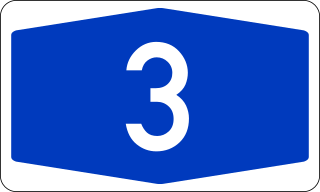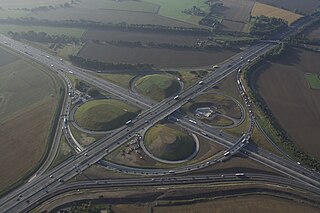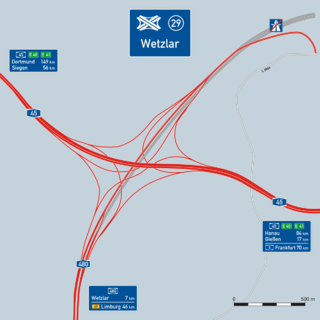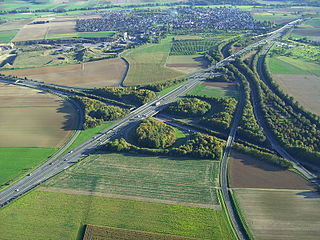
A cloverleaf interchange is a two-level interchange in which all turns are handled by slip roads. To go left, vehicles first continue as one road passes over or under the other, then exit right onto a one-way three-fourths loop ramp (270°) and merge onto the intersecting road. The objective of a cloverleaf is to allow two highways to cross without the need for any traffic to be stopped by traffic lights. The limiting factor in the capacity of a cloverleaf interchange is traffic weaving.

Bundesautobahn 3 is an autobahn in Germany running from the Germany-Netherlands border near Wesel in the northwest to the Germany-Austria border near Passau.

The Kamener Kreuz was formerly a full cloverleaf interchange near Dortmund in North Rhine-Westphalia Germany where the Autobahnen A1 and A2 meet. It lies between the towns of Kamen and Bergkamen in the west and the city of Hamm and the municipality Bönen in the east. The Kamener Kreuz, opened in 1937, was the second interchange between two Reichsautobahnen, the first one being the Schkeuditzer Kreuz. It is used by 160,000 vehicles per day.
A junction is where two or more roads meet.

Bundesautobahn 643 is a 8.4-kilometer (5.2 mi) short autobahn in Germany. The motorway crosses the Rhine River, connecting the cities of Wiesbaden and Mainz, the capital cities of the German states of Hesse and Rhineland-Palatinate, respectively. It is one of two autobahns in Germany that connect two neighboring state capitals in only one exit.

The Wetzlarer Kreuz is an Autobahn interchange in the city of Wetzlar in Hesse, Germany where the highways A45 and A480 meet. This junction is a stack interchange, which is the only fully built stack interchange in Germany.
The Breckenheim–Wiesbaden railway is a 13-kilometre (8.1 mi) long railway line in the vicinity of the Hessian state capital of Wiesbaden. It connects the Cologne–Frankfurt high-speed rail line with Wiesbaden Central Station.

The Kreuz Kaiserberg is a spaghetti junction in the Metropolitan region Rhein-Ruhr in the German state of Northrhine-Westphalia.
The Kreuz Oranienburg is a partial cloverleaf with a semi-direct link in the German state Brandenburg in the Metropolitan region of Berlin.
The Dreieck Havelland is a trumpet interchange in the German state of Brandenburg in the metropolitan region of Berlin.
The Kreuz Hegau is a Directional T interchange/Half-Cloverleaf interchange in the German state of Baden-Württemberg.

The Kreuz Chemnitz is a partial cloverleaf interchange with a direct link east–south and vice versa in the German state of Saxony.

The Schönefelder Kreuz is a cloverleaf interchange, with a direct link Magdeburg-Berlin and also a direct link Frankfurt (Oder)-Dresden, in the German state of Brandenburg in the metropolitan region of Berlin-Brandenburg.
The Kreuz Hilden is a cloverleaf interchange in the German state North Rhine Westphalia.

The Gambacher Kreuz is a cloverleaf interchange in Hesse, Germany where the A5 Autobahn from Basel to Bad Hersfeld intersects the A45 between Dortmund and Aschaffenburg. It constitutes a node in the primary route between the Rhein-Main metropolitan area and the eastern end of the Ruhr valley.
The Offenbacher Kreuz is a cloverleaf interchange in the Frankfurt Rhine-Main Metropolitan Region in the German state of Hesse.

The Hermsdorfer Kreuz is a cloverleaf interchange in the German state Thuringia.

The Kreuz Herne is a combination interchange with two cloverleaf links in the German state North Rhine-Westphalia.
The Kreuz Hamburg-Ost is a basketweave interchange with two semi-direct links in the German states Schleswig-Holstein and Hamburg.
The Kreuz Meckenheim is a cloverleaf interchange that connects the Bundesautobahn 61 and 565 with each other. It is located in the south of the town of Meckenheim in the Rhein-Sieg-Kreis, a small piece on the southeast side is in the area of the neighboring municipality of Graftschaft in the Ahrweiler district (Rhineland-Palatinate).












